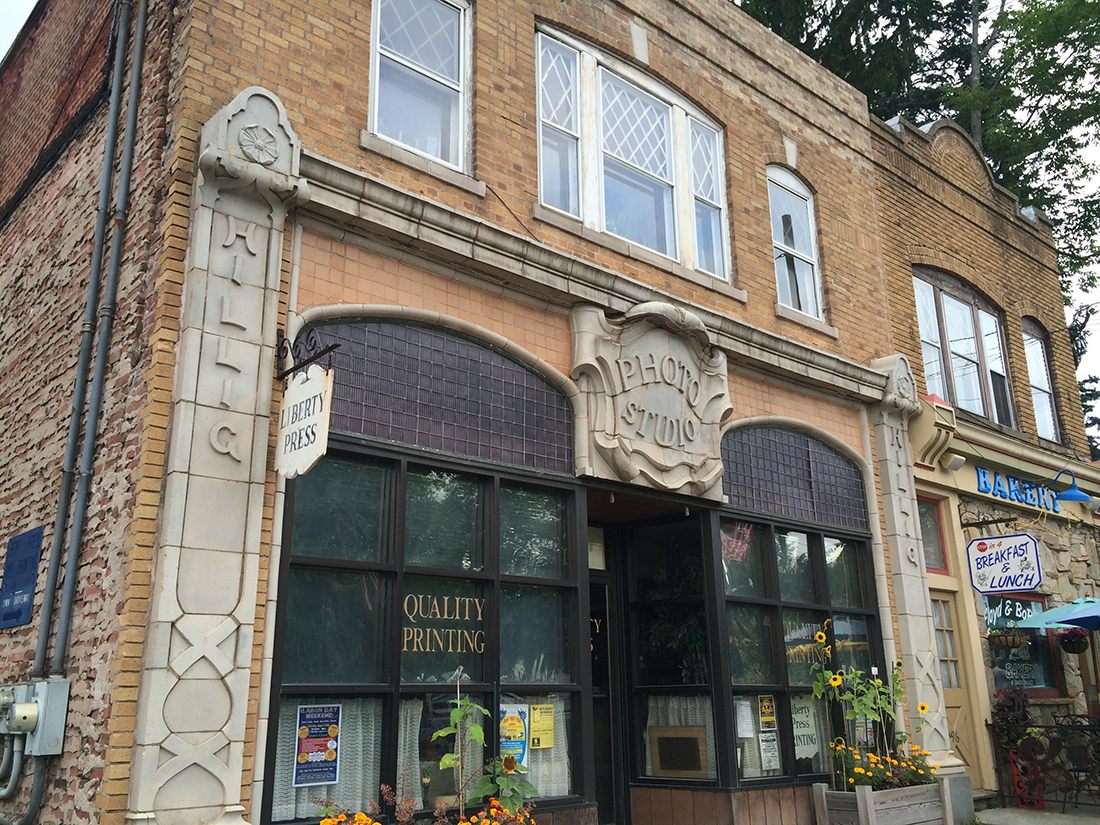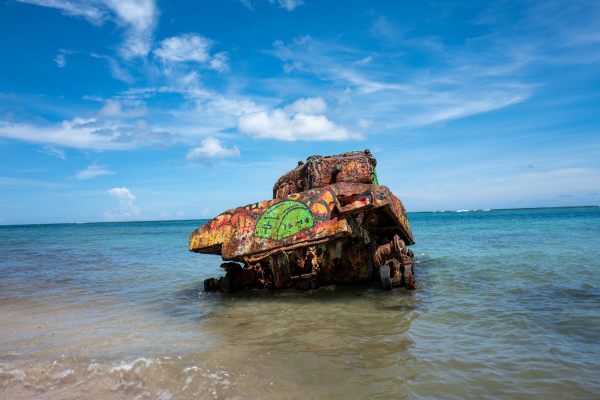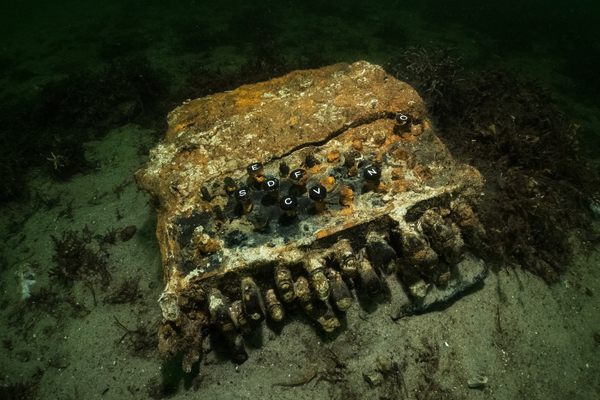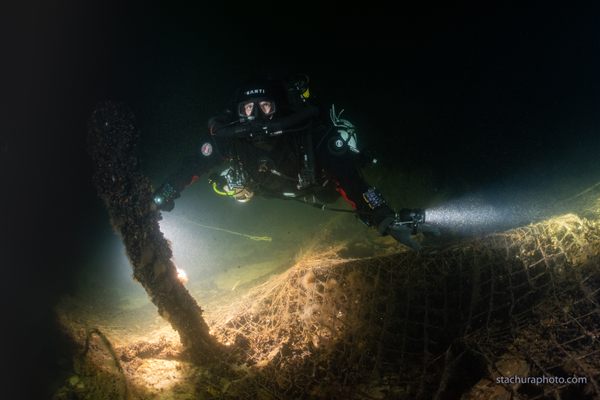Buried Somewhere in the Catskills is a Stash of Nazi Loot
An amateur pilot halted Nazi saboteurs during WWII, but did he then steal their war chest of cash?

Liberty monoplane over New York City on first leg of its flight to Denmark, with Otto Hillig, photographer, and Capt. Hoérüs, pilot. (Photo: Courtesy of the Boston Public Library, Leslie Jones Collection)
During a recent expedition to explore the abandoned holiday resort of Grossinger’s, located in the Catskills in upstate New York, I came across a charming old photography studio in the neighboring town of Liberty.
Decorated in beautiful tile, with Art Deco flourishes, and currently home to a small print shop, it was to become the key to unearthing a remarkable tale of undiscovered Nazi treasure, hidden right there in Sullivan County, New York State.
The story involves a forgotten hero from the golden age of aviation, a mysterious forest castle once owned by the Freemasons, and an invasion of German saboteurs during World War II.

A postcard showing Grossinger’s pool. The resort closed its doors in 1986. (Photo: 1950sUnlimited/CC BY 2.0)
Grossinger’s Resort was once the jewel in the crown of the so-called Borscht Belt. During the 1950s, the definition of a summer vacation for many Jewish New Yorkers was to head upstate to the holiday resorts of the Catskills. And Grossinger’s was the glitziest of them all.
In its heyday, Grossinger’s attracted over 150,000 revelers each year to be entertained by the likes of Jerry Lewis and Milton Berle. But the advent of cheap airfares to Florida saw the popularity of the Borscht Belt swiftly decline.
Grossinger’s finally closed in 1986. Today it is an enchanting abandoned ruin, a complex of swimming pools, tennis courts, an ice rink, and ballrooms gradually being reclaimed by nature.

The pool as it looks today. In its heyday, over 150,000 holiday makers would come to the resort every year. (Photo: Luke Spencer)
As the fortunes of Grossinger’s dwindled, so too did the nearby town of Liberty. While the lack of local employment resulted in some of the newer buildings closing, there remains a charming old historic district of about a dozen buildings.
One of these, located at 84 North Main Street was a photography studio owned by a German emigre named Otto Hillig. The exterior is decorated with a beautiful facade, a large cartouche and stylized columns that bear his surname.

Number 84, North Main Street, Liberty, NY, Otto Hillig’s photography studio. (Photo: Luke Spencer)
Before setting up his photography studio, Hillig found a small amount of fame as an amateur adventurer. In 1916, he drove across America at a time when even owning an automobile was rare. In the 1920s his passions turned to aviation.
He bought a Bellanca monoplane, which, with its Wright-powered engine had a top speed of just over 130 miles an hour. Otto christened the plane “Liberty” in honor of the small town. In 1931, he and Danish pilot Holger Hoiriis flew in it from New York to Denmark. Their journey was just the 10th ever transatlantic flight.
Hillig kept his plane at a small airfield by what would one day become the golf course attached to Grossinger’s Resort. According to a story printed in the Sullivan County Democrat in 1992, one day in the summer of 1942, Hillig and Hoiriis were tinkering with the Liberty, preparing for an evening’s flight, when they were approached by two men armed with revolvers.
They ordered Hillig and Hoiriis into the plane and forced them to fly southeast to Long Island. In the air, the two armed men apparently revealed themselves to be German saboteurs. They showed Hillig a vast sum of cash and said their plan was to buy enough explosives to blow up the railway line that ran from the armaments factories upstate to New York City and the Brooklyn Navy Yards.
Thinking quickly, Hillig motioned to Hoiriis, who suddenly flipped the plane. Hillig took the opportunity to grab the revolver kept in the cabin, and fatally shot the disoriented Nazi saboteurs. After returning to the Grossinger’s airfield, the shaken friends contacted the police and turned over the two dead enemy agents to the authorities.

Otto Hillig, far left, with his pilot, Captain Hoiriis, second from right. (Photo: National Library of Denmark)
According to the Democrat tale, Hillig didn’t mention the money. He kept that to himself. The federal government moved quickly to suppress the story; Hoiriis and Hillig were sworn to secrecy and news of the Germans’ hijacking was withheld from the press to avoid scaring the American public.
German saboteurs were a real threat during World War II, but their plots, when discovered, were often handled with similar secrecy. There were at least two small-scale landings on mainland U.S. soil during the war. In May 1942, four members of the Abwehr, a German intelligence service, landed in a U-Boat on a beach near Amagansett, on Long Island, New York. Three weeks later, a U-Boat filled with another four enemy agents arrived in Ponte Vedra Beach, Florida.

A World War Two pamphlet warning about saboteurs. (Photo: National Archives 44-PA-694)
On both occasions, the saboteurs were caught by the FBI. In August 1942, six of the eight were executed at the District of Columbia Jail. (A small plaque hidden in a clearing at the former Washington Asylum Potters Field—now a wood-bound water treatment facility—bears the inscription, “in memory of agents of the German Abwehr executed August 8th, 1942.”) The U.S. government had little interest in publicizing any of these feats, however.
Hillig and Hoiriis remained true to their word and never mentioned their dramatic wartime escapade. Hillig went back to his photography studio, and finally completed work on a castle he had begun building in the mid-1930s.
But what of the cash that allegedly changed hands when the Germans hijacked the Liberty?
Well, back to that Sullivan County Democrat story. It says that when Otto Hillig died on September 12, 1954, he left a rather unusual will. In addition to bequeathing his castle to the Grand Lodge of the Masons for New York State, Hillig left a specific instruction to be carried out by a young assistant at his photography studio. It concerned the stash of Nazi money.
The will said that on August 1, 1992—50 years after the fateful flight of the Liberty—the assistant was to dig up the money, at the unspecified spot where Hillig and Hoiriis had buried it, then put it in a safety deposit box in the branch of the Sullivan County National Bank. The assistant was then required to hide a gold coin, stamped “OH” for Otto Hillig, in the place where the money had been hidden.
Once the money was deposited and the coin hidden, the assistant was to hand in a report to the Democrat. Written by Hillig, and sprinkled with clues as to the buried coin’s location, it would finally tell the story of the German saboteurs.

Built in 1914, Hillig’s studio was listed on the National Register of Historic Places in 1978. (Photo: Luke Spencer)
True to his word, Hillig’s assistant followed his employer’s final wishes. Hillig’s story was printed in the newspaper and also reproduced in the local historical society newsletter. Following its publication, treasure hunters scoured the castle, the old photography studio and Grossinger’s itself. But the coin was never found.
Twenty-five years later, the story remains little known. Grossinger’s Resort continues to silently fall apart. Hillig’s castle was for many years left abandoned, until it was bought from the Freemasons and turned into a private residence. Hillig’s photography studio became a bakery and then a print shop, but still bears his name in beautiful tile work outside.
The mystery of the buried coin was never solved, and today, a stash of Nazi loot is believed to lie unclaimed in a forgotten safety deposit box in a quiet town in upstate New York.
Update (4/12): This story has been updated to reflect the fact that the hijacking story and the existence of Nazi loot are taken from a tale published in the Sullivan County Democrat. While this part of the narrative is an established local legend, its veracity is uncertain. Now that April Fool’s Day has passed, we invite closer scrutiny of the details.



















Follow us on Twitter to get the latest on the world's hidden wonders.
Like us on Facebook to get the latest on the world's hidden wonders.
Follow us on Twitter Like us on Facebook